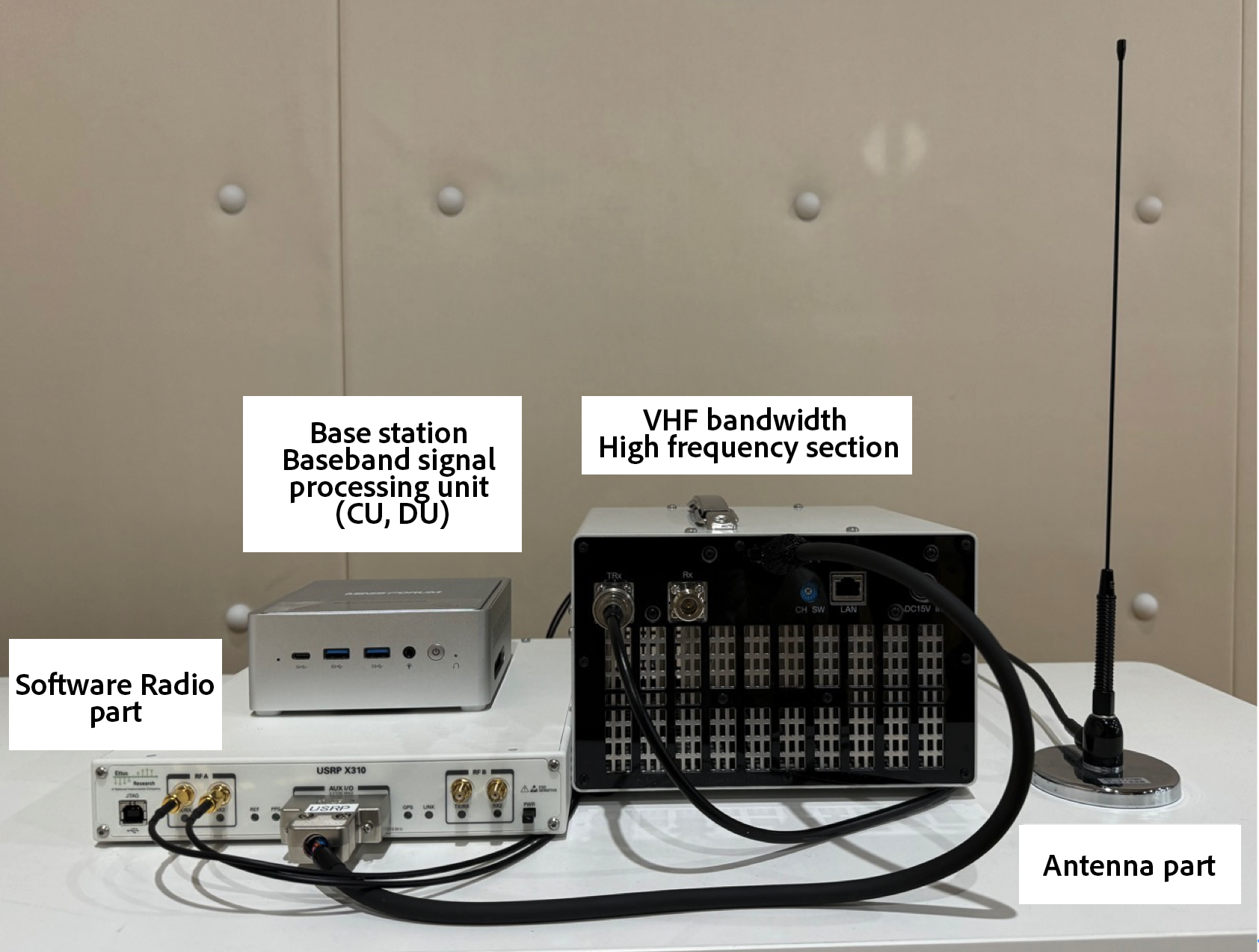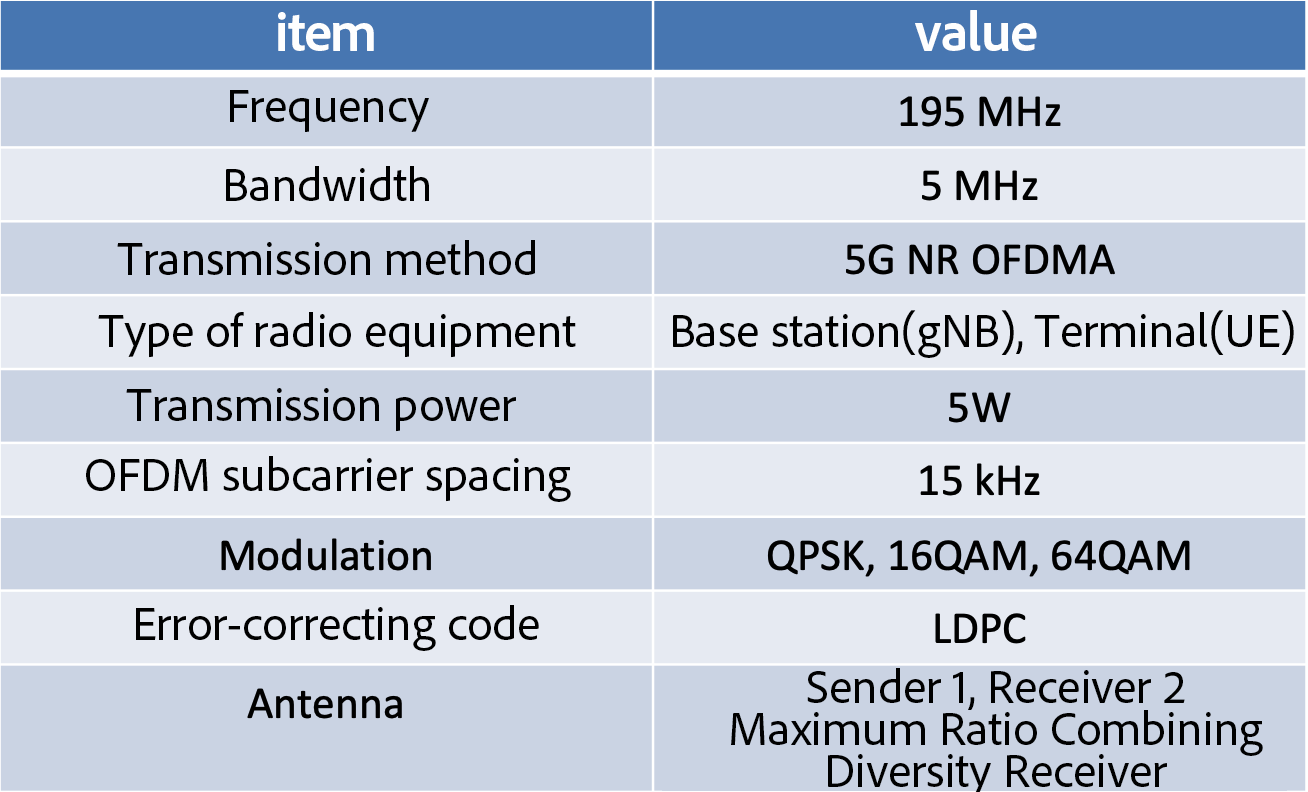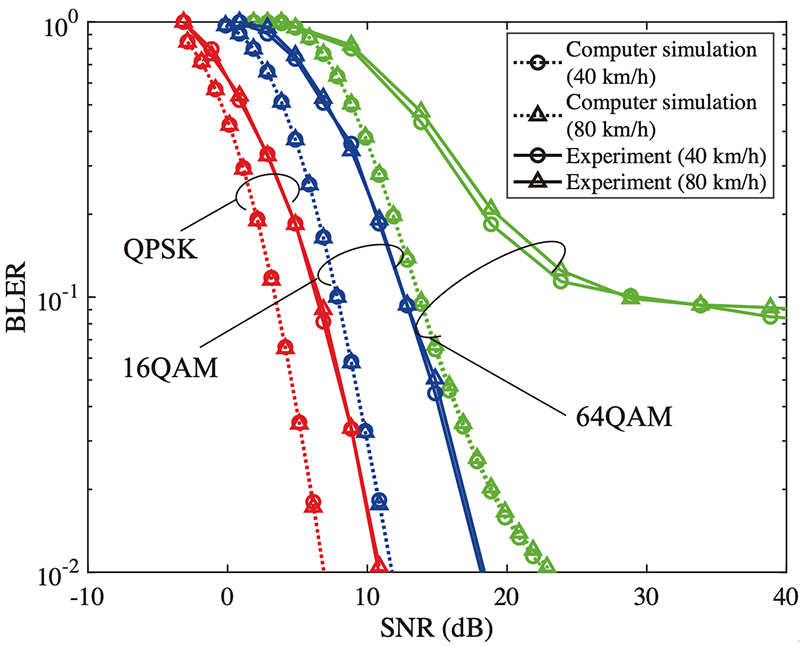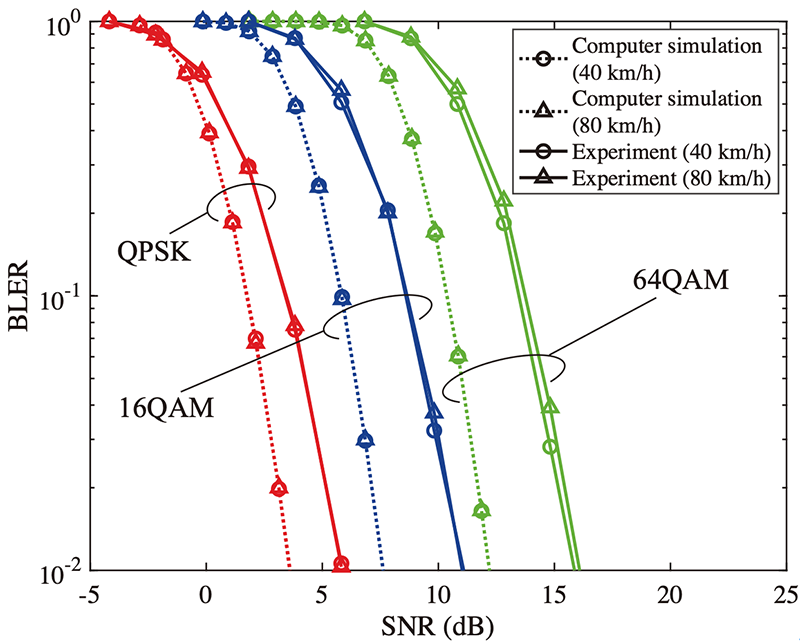






[Home] » [Press Release]
Successful Development of Ultra-Wideband Compact Self- Maintained (Private) 5G System Using Software Radio Technology in the VHF Band
| Digital Communications Laboratory led by Professor Hiroshi Harada of the Graduate School of Informatics at Kyoto University (hereafter referred to as “Kyoto University”) has successfully developed an ultra-wideband, compact, self-managed (private) 5G system—consisting of a base station and terminals—using a band. This system achieves a communication range of over 10 km by utilizing mobile-capable high-frequency technology in the VHF band and software radio technology based on open-source solutions. This achievement enables the provision of a simple 5G system for various applications, including sensors, meters, and monitors within a limited range of several to 10 km, as well as for temporary information and video transmission during disasters. |

|
Background
Research and development on next-generation communication systems, known as Beyond 5G and 6G systems, are underway to enhance the capabilities of current 5G systems used in cell phones. A key objective of these advanced systems is to achieve ultra-coverage wireless communication technology to maximize the coverage area. Although non-terrestrial networks (NTN: Non-Terrestrial Network) such as satellite communications, can be utilized for this purpose, NTN relies on relatively high frequencies (10 GHz or higher), which may result in communication interruptions due to obstacles, such as trees in mountainous areas. To address these challenges, Kyoto University has been researching, developing, standardizing, and commercializing broadband mobile communication systems using the VHF band (200 MHz band). This band has a wavelength 10 times longer than the frequency band used for conventional 5G (3 or 4 GHz band) and is expected to enable long-distance transmission. In particular, the team developed a radio system for the Wireless Regional Area Network (Wi-RAN), which supports mobile communications with a transmission rate of up to about 9 Mbps using orthogonal frequency division multiple access (OFDMA) and 5 MHz per channel. In October 2017, the system achieved a maximum transmission distance of 27 km. In June 2018, it successfully transmitted wireless video in a forested, non-line-of-sight environment, and in April 2019, it achieved wireless video transmission over a distance exceeding 100 km. Currently, Wi-RAN is internationally standardized and commercialized as a public broadband system in the VHF band and is used for video and information transmission at disaster sites. However, since both Wi-RAN and 5G systems use the same OFDMA transmission system, there is growing demand for 5G systems in the VHF band.
Research Methods and Results
By leveraging mobile-compatible high-frequency technology in the VHF band, originally developed for Wi-RAN, and software radio technology based on open-source solutions that support 5G, the team successfully developed an ultra-wide-area, compact private 5G system (base station and terminal) using the VHF band. This system is expected to achieve a communication range of over 10 km. We researched and developed the following three aspects:
- Using open-source technology that enables 5G NR, we implemented the baseband processing functions (known as CU and DU functions in 5G) and terminal functions (referred to as the UE function in 5G) of 5G NR base stations (known as gNB in 5G) in software within a compact PC measuring approximately 13 cm × 13 cm × 5.6 cm. (The basic specifications are listed in Table 1, and the base station configuration is shown in Figure 1.)
- We enabled 5G NR modulation and demodulation in the VHF band by connecting a software radio to each compact PC equipped with 5G NR base station and terminal functions. Furthermore, by linking it to the compact high-frequency VHF band section developed for Wi-RAN (shown in Figure 1), we achieved a transmission output of 5 W and implemented two-branch diversity on the receiver side.
- We newly developed and integrated an automatic power control (APC) function for the transmitter, essential for mobile communications, and an automatic gain control (AGC) function for the receiver. The AGC function automatically adjusts to provide consistent receiving power, even when signal strength fluctuates due to movement. By controlling the high-frequency section using these functions, high-quality transmission and reception can be maintained, even when the terminal moves at high speeds.
For the development of the 5G-NR virtual radio, open-source software from the Open-Air-Interface (OAI) Software Alliance was used, of which Kyoto University is the first official member in Japan. This software was configured to operate 5G-NR with radio parameters suitable for the VHF band. Using this base station and terminal, we conducted transmission characteristic tests in the laboratory with a fading emulator that simulated the radio propagation environment in a mobile communication setting. We then measured and evaluated the Block Error Rate (BLER) (Figure 2). The evaluation includes results from both actual device experiments and computer simulations using the technical computing language MATLAB. In an environment where the delay time of reflected waves is short due to multipath propagation in an urban area with a communication range of approximately 2 km (Figure 3, GSM Typical Urban Model), there was a slight degradation of several dB compared to the computer simulation. However, the results for QPSK, 16QAM, and 64QAM showed that the required BLER of 10% was achieved, even when moving at a maximum speed of 80 km/h. Meanwhile, in an environment with a large propagation delay of reflected waves—typical of a multipath environment in a suburban area with a communication range of about 10 km (Figure 4, IEEE 802.22 Profile A)—the system receives reflected waves with propagation delays (about 20 μs) that greatly exceed those assumed for the OFDMA transmission method used in 5G NR. As a result, although the BLER characteristics degrade (floor) compared to computer simulations at travel speeds of 40 km/h and 80 km/h, the required BLER is still achieved. This indicates that the newly developed device can maintain the necessary transmission characteristics even in a communication area of approximately 10 km. The maximum data transmission rate was also measured. A peak transmission rate of 16.2 Mbps was achieved in an environment with minimal propagation delay due to multiple reflected radio waves, while a rate of 8.5 Mbps was recorded in an environment with significant propagation delay, typical of a suburban area.

|

|

|

|
Impacts and Future Plans
These verification results demonstrate that a self-operated (private) 5G system using the VHF band can support mobile communications at data transmission rates suitable for video transmission, even within an communication area of up to 10 km. This success enables the easy provision of 5G systems for various applications that require sensors, meters, and monitors within a limited range of several kilometers to 10 km, as well as for temporary information and video transmission during disasters. In the future, we will evaluate the transmission characteristics of this radio equipment in various application fields and aim to standardize and commercialize 5G in the VHF band for private systems.
Acknowledgements
This study was conducted as part of a contract research project (05101) sponsored by the National Institute of Information and Communications Technology (NICT).
Terminologies
» 1. VHF bandwidth
This refers to the frequency range of 30–300 MHz. The 200 MHz band was used for this project. Since the wavelength is more than 10 times longer than that of the frequency band used for ordinary 5G (3 and 4 GHz bands), long-distance transmission is expected with the same transmission power. The 200 MHz band was originally used for analog television broadcasting but is now being utilized as a broadband frequency for public use through Wi-RAN, which has a bandwidth of 5 MHz per channel.
» 2. 5G New-Radio
This is a radio interface adopted in 5G and standardized by the International Standardization Organization 3GPP (3rd Generation Partnership Project). It enables flexible signal generation for various applications.
» 3. OAI(OpenAirInterface) software Alliance
The OAI Alliance was established in 2014 to build 5G systems using open-source software. By installing the 5G NR software provided by the OAI Alliance on a PC or other device, the signal processing functions of the 5G system (core network, base station, and terminals), as defined by the 3GPP standardization organization, can be implemented. Modifying and adding software enables various research and development activities. Kyoto University was the first university in Japan to join this alliance.
» 4. Multiple propagation of radio waves (multipath) environment
When there are various buildings or other obstacles between the transmitter and receiver, the receiver not only receives the direct wave from the transmitter but also delayed waves that are reflected off various objects. These reflected waves arrive later than the direct wave, creating a multipath environment. The delayed waves have different signal levels and phases due to reflection, and if the delay is significant, interference between successive data transmissions may occur, requiring countermeasures. Various models are available to simulate this multipath environment. In this evaluation, the GSM Typical Urban Model (with a maximum delay time of 5 µs) is used for urban areas with communication ranges of about 2 km, while the IEEE 802.22 Profile A (with a maximum delay time of 21 µs) is used for suburban areas with communication ranges of about 10 km.
|
Contact Information |
|
[For Research Inquiries] |
|
[For Press and Media Inquiries] *Please change [at] to @ |